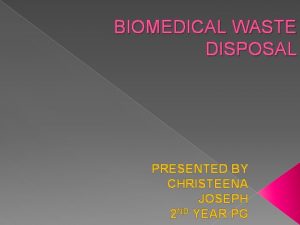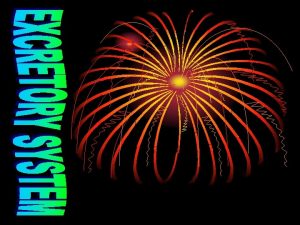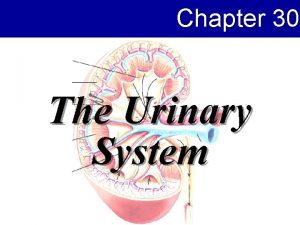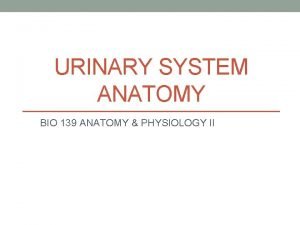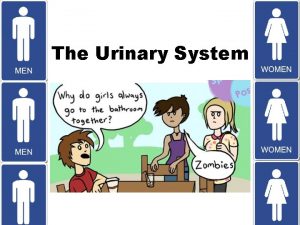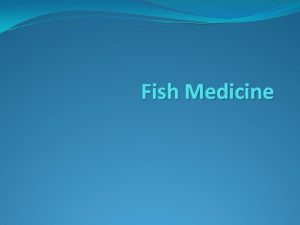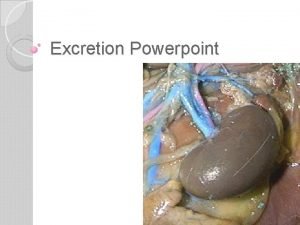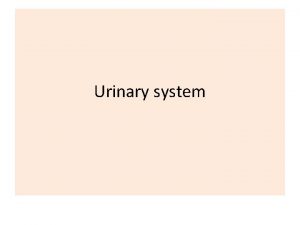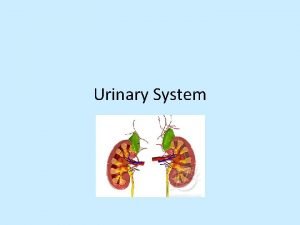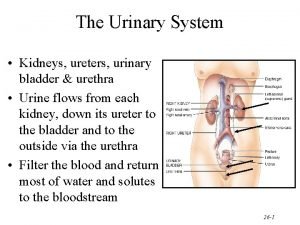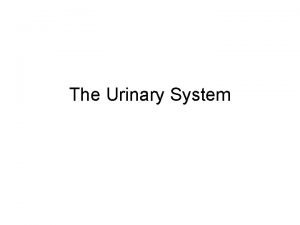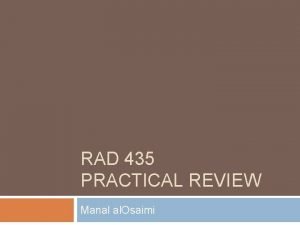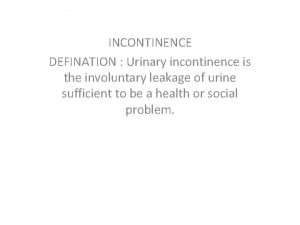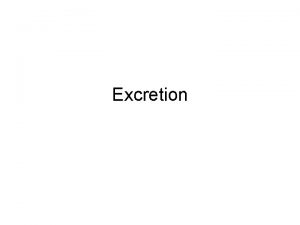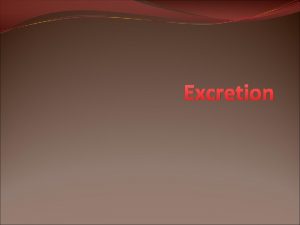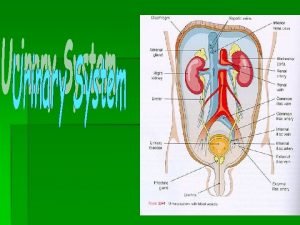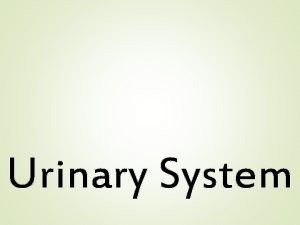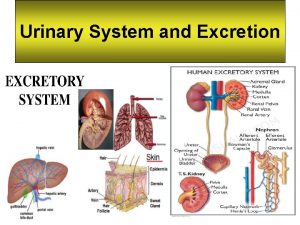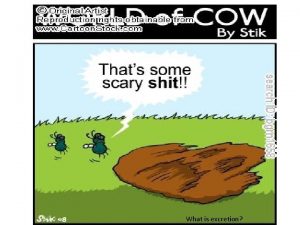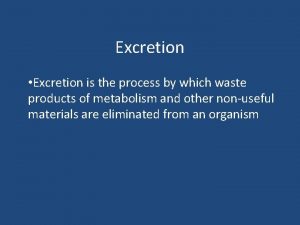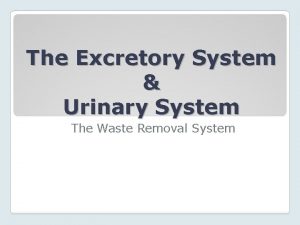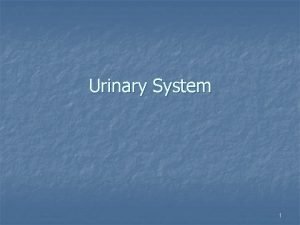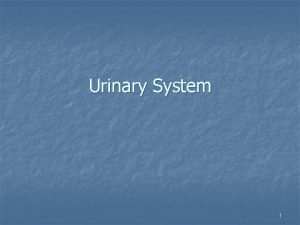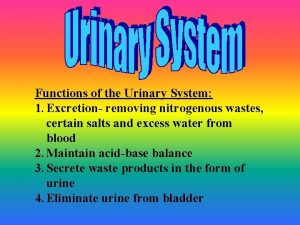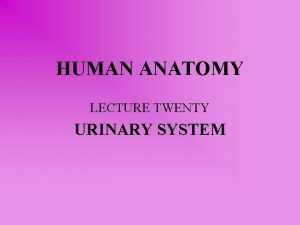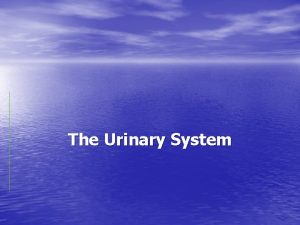URINARY SYSTEM Functions Excretion removal of organic waste






















- Slides: 22

URINARY SYSTEM

Functions Excretion – removal of organic waste products from body fluids Elimination – discharge of these waste products into environment Maintains normal volume and solute concentration of blood plasma

4 Major Components Kidney Ureter Bladder Urethra

Kidneys Filter waste from blood Reabsorb substances the body requires


Anatomy of the Kidney Cortex is the outer portion Medulla is the inner portion Calyces give urine to renal pelvis

Pathway of Blood in the Kidney

Nephrons Structural and functional unit of kidney A kidney contains about 1 million nephrons

Bowman’s capsule – double-walled sac which surrounds the glomerulus Glomerulus – cluster of capillaries; filters out substances from blood water, salt, waste

Loop of Henle Osmosis in the Loop of Henle allows our kidney to maintain proper water concentration: waste products to pass into the bloodstream; water and salt are reabsorbed at the same time


Ureters Slender tubes Runs from the hilus of kidney to posterior aspect of bladder Passageways that carry urine Peristalsis helps the ureters to propel urine to bladder

Bladder Smooth, collapsible muscular sac that stretches as it fills with urine A moderately full bladder holds about 1 pint/500 ml of urine, but is capable of holding more than twice that amount.

Urethra Thin-walled tube that carries urine by peristalsis from the bladder to the outside of the body Sphincters n Internal urethral sphincter- involuntary sphincter that keeps the urethra closed when urine is not being passed; at the bladder-urethra junction n External urethral sphincter- voluntary sphincter made of skeletal muscle

Control of blood composition by the kidneys Urine Contains n Water & Urea (the main contributor of Nitrogenous waste)

Maintaining balance Water accounts for about 60% (give or take) of body weight The average adult takes in about 2 ½ quarts of water a day (half from food) Water is lost through urine, fecal matter, expiration & perspiration

ADH Antidiuretic hormone (ADH)- functions to conserve water output into urine n n n Low water intake=more ADH=less urine excreted High water intake=low ADH= more urine excreted Alcohol prevents release of ADH causing low water reabsorption and increased urine production.

Common Diuretics Alcohol Caffeine Pregnancy Diabetes

Urination Process of releasing urine through the urethra Ordinarily, the bladder collects urine until about 200 ml have accumulated. The stretching of the bladder activates stretch receptors, leading to reflex contractions.

Contractions become stronger, forcing stored urine past the internal sphincter into the upper part of the urethra. Now the person feels the urge to urinate. The lower external sphincter can be voluntarily controlled. n n n Bladder emptying can be postponed if desired, causing the reflex contractions to stop within a minute or so. If convenient, the external sphincter can be relaxed so that urine is flushed form the body. But eventually, urination will occur whether one wills it or not.

Kidney Stones n n Salts and calcium found in concentrated urine can crystallize to become a stone Causes pain and reduces or prevents filtration in the affected kidney

Closure What is the function of the Kidneys? Describe the loop of Henle include regions that are hypertonic and hypotonic. (include bowman’s capsule, descending loop, ascending loop and collecting duct) Give a situation in which your body would have low ADH. Give a situation in which your body would have high ADH. Why is it important to maintain of your bodies osmotic pressure?
 Lymphatic and urinary system
Lymphatic and urinary system Human pathological waste
Human pathological waste Cellular waste removal
Cellular waste removal Urinary system introduction
Urinary system introduction Glomerular filtration
Glomerular filtration Combining form for urinary bladder
Combining form for urinary bladder Interesting facts about urinary system
Interesting facts about urinary system Fetal pig female reproductive system
Fetal pig female reproductive system The urinary system chapter 30
The urinary system chapter 30 Chapter 15 the urinary system figure 15-3
Chapter 15 the urinary system figure 15-3 Chapter 20 urinary/excretory system
Chapter 20 urinary/excretory system Urinary system model
Urinary system model Urinary system fun fact
Urinary system fun fact Alimentary canal
Alimentary canal Urinary system powerpoint
Urinary system powerpoint The urinary system is also known as
The urinary system is also known as Antidiuretic hormone function
Antidiuretic hormone function Nephron urinary system
Nephron urinary system Figure 15-3 is a diagram of the nephron
Figure 15-3 is a diagram of the nephron Hysterosalpingography
Hysterosalpingography Defination of urine
Defination of urine Homework
Homework External anatomy of a rat
External anatomy of a rat

